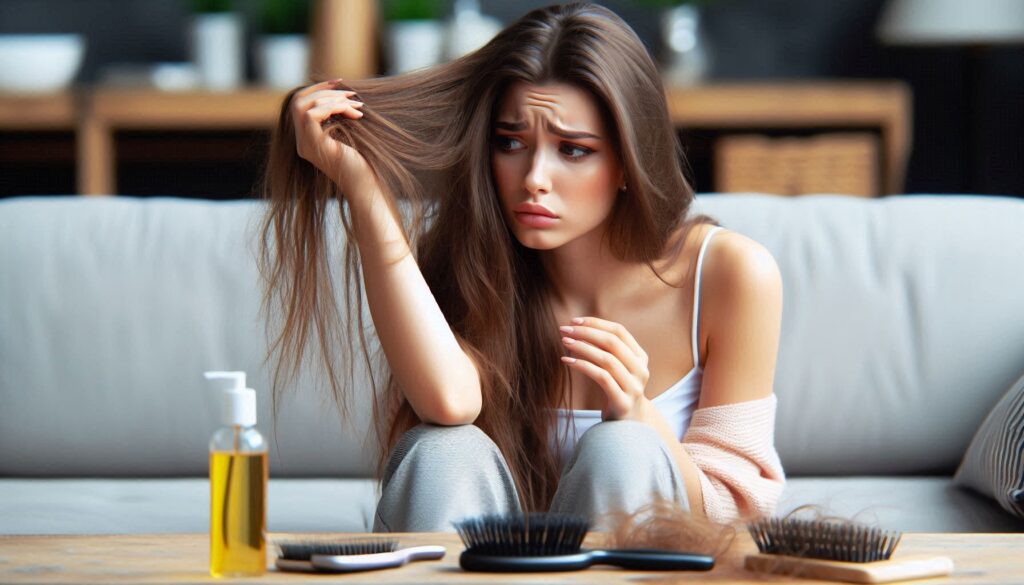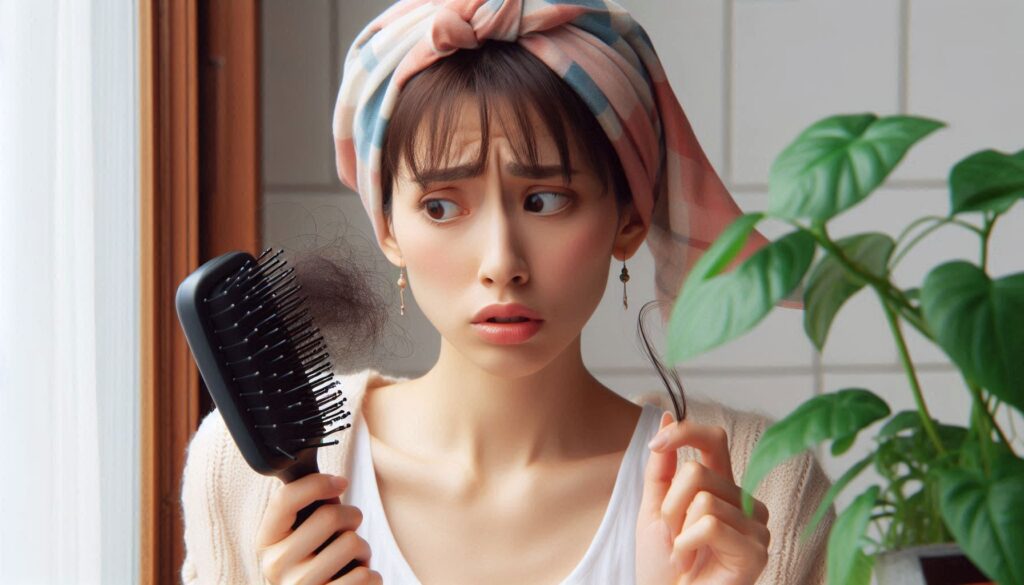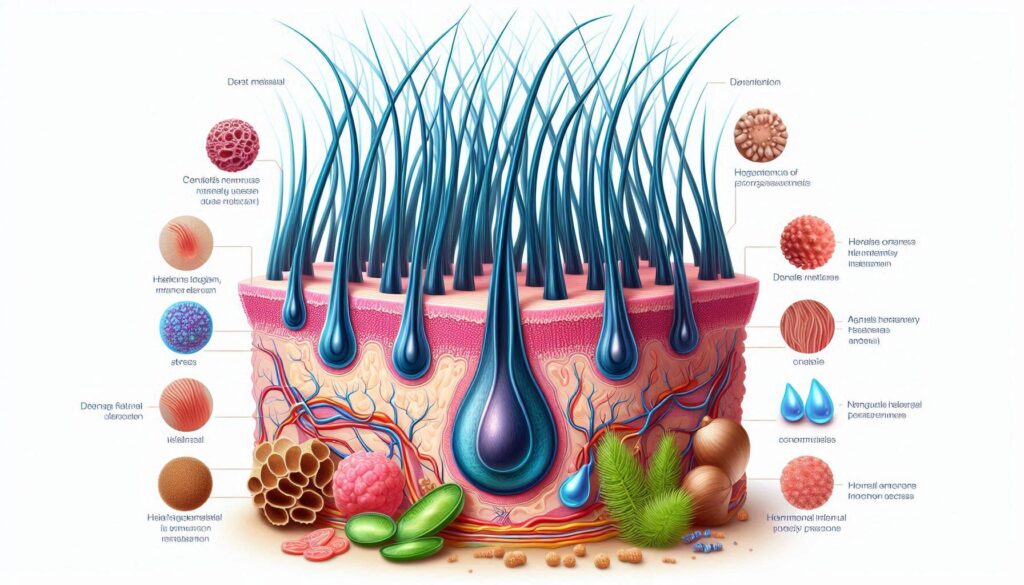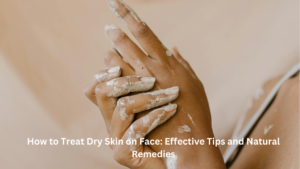What Causes Hair Loss: Understanding the Factors and Finding Solutions, For several people, particularly women, with hair loss, it may affect not only their physical appearance but also their self-confidence. Thus, the difficulty with hair loss can be very distressing because one’s hair is usually considered an essential aspect of themselves. Once someone understands the reasons for hair loss, they can discuss the problem constructively and, most importantly, find the best ways to deal with the problem. This detailed article will discuss many issues concerning the loss of hair, including but not limited to, woman hair fall, the process of losing hair, baldness causes, cures for the female hair loss and causes of hair loss in general.
hair fall in female

The issue of hair fall in females is a common practice which can arise from numerous reasons. There are hormonal fluctuations as in pregnancy, childbirth and menopause which causes a great deal of hair loss. Other reasons include certain medical conditions such as hypothyroidism or polycystic ovary syndrome (PCOS) which may also induce hair thinning. Along with that, stress, nutritional deficiencies as well as some drugs may also cause excessive falling hair. It is not uncommon for women to experience hair loss for various reasons but it is important to find these factors sooner so that the necessary measures can be taken to help curb hair loss.
- Hormonal Influences: One of the most common reasons for hair loss in women is the change in hormone levels. In pregnancy, the high levels of estrogen may extend the hair growth stage and as a result most women will have fuller hair. However, postpartum motherhood sees a drastic decline in the levels of estrogen and thus many women tend to lose a lot of hair. Another critical transitional period with many hormonal changes is the period around menopause, which may lead to hair loss in women in the form of thin hair or hair patches. Thyroid diseases, especially hypothyroidism and hyperthyroidism, are also known to alter normal hair growth patterns resulting in hair loss.
- Stress And Hair Loss: People that are stressed a lot perspire more and tend to loose hair. This condition, which many people experience ashamedly, is called telogen effluvium. Emotional pressure can lead to this kind of strain as well as physical strain of medical procedures or diseases as in this case. To this end, eliminating causes of stress by practicing relaxation, exercises and leading healthy life styles can also minimize the rate of the hair loss.
- Nutritional Deficiencies: The food that one takes determines in a big extent the state of the hair. Shortage of vital elements like iron and zinc, vitamin a, d and e, along with b complex derivatives result in hair loss and thinning down of hair. Women, especially, have been noted to suffer from anemia due to iron deficiency which leads to drastic hair loss. Therefore, either having a balanced diet or using enriched diet supplements is advisable for better hair growth.
- Medications and Hair Loss: Some drugs when taken as prescribed may result to hair loss among other effects. This includes medications used for treatment of cancer (chemotherapy), arthritis, anti-depressants, heart disease and hypertensive drugs. When a person believes that he/she is losing hair due to a medication, the person should inform the doctor. In which case an alternative treatment may be recommended or the side effects managed.
- Genetic Factors: Androgenetic alopecia or female pattern hair loss is a condition that is genetic in nature and occurs in a lot of women. It is usually seen as a loss of hair on the mid scalp and reserved on the other regions. Such hair loss occurs slowly with the patient realizing it more so with old age. Those affected can use topical minoxidil to decrease the rate with which hair loss is experienced and even help with regrowth of hair.
hair falling off

On most occasions, hair loss or shedding is common and harmless, but it becomes a cause of concern especially when the amounts involved are large. This is called telogen effluvium and occurs as a result of either physical or psychological stresses such as surgery or illnesses or rapid weight changes. Unlike chronic hair loss, this type happens temporarily. After a period of absence when the cause or the trigger is dealt with, the falling hair resumes. Yet, looking for a medical specialist is crucial in case of consistent loss of hair for further examination in order to amicably address the problem, as there are certain health issues that could be more serious.
- The resting of hair follicles: This condition comes as a result the large chunk of hair follicles shifting to the telogen (resting stage) at the same time leading to excessive hair loss. This may occur as a result of stress, major physiologic or surgical trauma, high-grade fevers, infections, or rapid physiologic decompensation i.e. weight loss. In most cases, shedding begins around two to three months post the event and may remain for quit a while. In most instances, this is followed by resolution of the cause and hair growth resumes, although it may take some time for hairs to regrow to those densities which were previously in place.
- Anagen Effluvium: this type of loss of hair occurs during the (anagen) phase of the hairs cycle. Chemotherapy and radiation therapy used in cancer management are typical causes of destruction of hair maintenance structures very fast. The hair loss is quite common and widespread when it happens, with the head and other parts of the body being affected. Once treatment is over, hair often comes back but with a different texture and color.
- Alopecia Areata: An autoimmune condition that results in uneven hair growth on the scalp and face and other regions of the body. It is an autoimmune condition where hair follicles are attacked and thus causing the loss of hair. Although there are different forms of alopecia, the reasons behind alopecia areata are still a mystery; however, it can be caused by stress or illness. Therapies available include steroids, immunotherapy creams and minoxidil in order to enhance hair.
- Androgenetic Alopecia Trigger Factors Professional Guide. Androgenetic alopecia has been shown to be more prevalent in specific groups as a result of environmental conditions, cultural practices and religious beliefs So many diverse societ teaches you how to As indicated earlier, this condition is more prevalent Androgenetic alopecia has been shown to Androgenetic alopecia has been shown to
what causes baldness

Normal physiological hair growth consists of recurrent active, catagen and dormant phases. More than six months of hair shedding without full recovery comes under chronic telogen effluvium. It is associated more with females and may be induced by prolonged stress, hormonal changes or lack of some nutrients in food. Treating the causative factors and keeping fit are effective in minimizing chronic telogen effluvium.
Perhaps the most important cause of baldness is genetic predisposition. Baldness in men and women is associated with different changes in the hair growth cycle. In men, baldness may begin with a receding hairline and balding at the crown of the head while, women tend to experience diffuse pattern of hair loss across their scalps. This condition is primarily due to the actions of hormones, mainly dihydrotestosterone (DHT) . In addition to these, causes of hair loss include dietary issues, psychosocial stress, and some health conditions. It is crucial to understand these in order to design treatments which will either halt the process or restore hair that has already been lost.
Androgenetic alopecia is the most prevalent type of hair loss in both men and women. This is the most prevalent form of hair loss. It is due to genetic factors as well as the action of androgens. In men, one begins with a receding frontal hairline and thinning of the hair on top of the head leading to partial or total scalp hair loss. and In women, the recession is more diffuse over the scalp, with hair loss of the frontal hair line. Androgenetic alopecia is particularly multi-faceted since the male hormone, dihydrotestosterone (DHT), is responsible for shrinking hair follicles and consequently hair strands that grow tend to be shorter and finer.
Hormonal Changes Instead, obsessive thought patterns coupled with confrontational theories had begun to assuage the suffering of most women striken with baldness and the fear which beset those who had them. The hair cycle is made up of normal active growth (anagen), transitional and resting phases (catagen and telogen respectively). Hair shedding lasting more than six months with no complete regrowth is termed as chronic telogen effluvium. It is associated more with the female gender and may occur due to prolonged pressure, hormonal shift, or more commonly inadequate nutrients from the diet. In minimising chronic telogen effluvium, treating the causative factors and keeping fit are effective measures.
Ira_Russia24 What Causes Hair Loss Here exploring the most common ones. However, the most important cause of baldness is genetic tendency. Baldness in men and in women refers to different hair growth cycle changes. In a man baldness would start with receding frontal hair line and bald patches on the head s crown while women would have a diffuse pattern of hair loss across the scalp. This condition is mainly caused by the effect of hormones, particularly the derivate of testosterone known as dihydrotestosterone (DHT) . Besides causes of baldness include drokurtic fibers, hair pulling, bad nutrition, psycho-emotional stress and some other diseases. It’s very important to know these kays cause and effects of health loss in order to prevent and even cure hair autumn.
Possible Causes Of Hair Loss In Humans And Patterns Of Bitationa Androgenetic Alopecia Treatment And Prevention. The most widespread type of baldness is Androgenetic alopecia. Androgenic alopecia is multifactorial; genetic susceptibility and androgens are implicated. In men, it begins as a receding hairline and thinning of the crown.
female hair loss cure

Cures for Female Hair Thinning The very first step in overcoming female pattern hair thinning is to identify the cause of the disorder. In hormonal imbalances for example, one can use hormone replacement therapy or even birth control pills. Solutions for example minoxidil applied to the scalp can provide much needed artificial stimulation to speed up hair growth along with minimize hair loss. More sophisticated procedures like low-level laser therapy (LLLT) and platelet-rich plasma (PRP) therapy have been quite effective to enhance hair growth restoration. Furthermore, it is important to understand modification in style habits such as healthy eating, stress management and use of non-damaging hair care products greatly enhance hair health.
Hormone Replacement Therapy (HRT): Failure to restore hormonal balance has serious effects on a woman’s healthy head of hair. HRT in particular is effective at managing and correcting hormonal imbalance and consequent hair thinning particularly in menopause women. In particular, birth control pills can decrease inappropriate hormonal activity and thus, decrease the excessive levels of androgens in women with PCOS or similar conditions and therefore lessen the rate of hair loss.
Topical Treatments: Minoxidil is a topical solution for treating hair loss for both men and women and is the only one approved by the FDA. This facilitates the activation of hair follicles and allows the hair cycle sustain the growth phase for a longer period. The application of Minoxidil, for instance twice a day will minimize the rate of hair loss and enhance hair growth. However it is important to use the product on a continual basis in order to preserve the benefits obtained.
LLLT (Low-Level Laser Therapy),: Another term given to low-level laser therapy is photobiostimulation; this is a category of treatment which is non-invasive and involves the application of red light on where hair follicles are located. It may be done at outside the clinic by using laser combs or helmets or can be done specifically using the professional equipment in the clinic. This therapy also works by stimulating the interior of the scalp, where blood circulation is enhanced, thus accelerating the growth of the hair.
hair loss causes

The reasons for hair fall are numerous, some of them being very intricate. Some of them are mentioned below:
- Heredity: Family history plays a major role when it comes to baldness. If your mother or father or even your grandparents suffered hair loss, the chances are that you will as well. Androgenetic alopecia, often referred to as male or female baldness, is the widespread form of hair loss that is inherited and is seen in both men and women.
- Hormonal Inbalance: Changes in hormones might also be causes of hair loss. Situations such as pregnancy, giving birth, menopause, as well as some disorders of the thyroid can contribute to a disturbance in the normal cycle of hair growth. Influence of such hormones as androgens can lead for example to atrophy of the hair follicle and consequently, fine hair.
- Diseases: There are health issues that can also have some effect on hair loss. Alopecia areata is an autoimmune condition in which the body’s immune system is responsible for attacking the hair follicles and results in hair loss. Hairfall can also occur due to hair and/or scalp diseases, for example, fungal infections or internal diseases. There are also specific skin conditions such as psoriasis and seborrheic dermitis that can affect the scalp resulting in hair loss.
- Side Effects: It is known that a number of drugs can effect hair re-growth. These include anticancer (chemotherapy) drugs, medications for arthritis, depression, heart and high blood pressure. Consider speaking to your health professional regarding the possibility of other drugs out there if you think that one of them is making you lose hair.
- Stress: The shedding and loss of hair can be triggered by both physiological and emotional stress. Telogen effluvium is a condition which refers to the early transition of hair follicles to the resting phase due to stress. Therefore, practicing stress management techniques such as exercise and a healthy diet can be of great help to overcome hair loss that is occasioned by stress.
- Nutritional Deficiencies: Hair can become brittle and fall out due to inadequate supply of important nutrients. Vitamins A, C, D, E, all B-vitamins, iron, and zinc as well as biotin deficiency can have adverse effects on hair. Therefore, consuming or supplementing ones diet with a food rich in these nutrients will enhance the health of one’s hair.
- Scalp Conditions: Conditions affecting the scalp, like dandruff, psoriasis as well as seborrheic dermatitis, can damage the hair roots hence causing hair loss. Treating the underlying condition of the scalp will help encourage hair growth and minimize hair loss.
Conclusion
Knowing the causes of hair loss is the beginning of the search for the best remedies. For instance, causes of hair fall in women are important when laying out the treatment plan. Whether it arises from hormonal shifts, genetics or lifestyle changes, such concerns can be effectively managed to stop the aggravation of hair loss and aid in the normal growth of hair. If you have any problems with hair loss consultation with a medical practitioner is recommended for a personal fitting treatment plan which will restore your self image. NEXT BLOG POST



